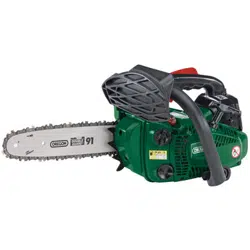Loading ...
Loading ...
Loading ...

8.2 FUEL & LUBRICATION (FIGS.13 – 16)
This chain saw is equipped with a 2 stroke air
cooled petrol engine.
This type of engine requires a mixture of fuel and
oil to perform and function. Failure to use the
correct oil, fuel or mixture ratio will cause
permanent damage to the engine. Only use fresh,
clean, good quality unleaded fuel mixed with a
high quality 2 stroke oil. Do not use any other
types of oil e.g. engine oil as this will cause
damage to the engine.
2-stroke mixture fuelling
For standard or semi-synthetic oil a mix ratio of 25:1
must be used. To mix a ratio of 25:1, add 0.2 litres
(200ml) of 2 stroke oil into 5 litres of unleaded fuel
(4%).
– Attention: Always handle fuel with caution.
Pour the fuel/oil mixture into a specifically
designed mixing receptacle before replacing the
cap and shaking gently. Remove the fuel tank
cap (6) by turning it anti-clockwise. To prevent
identification problems or accidents the power
head is stamped in the vicinity of the tank cap
with the fuel symbol.
– With the aid of a funnel pour the fuel/oil mixture
into the fuel tank before replacing the cap firmly.
Avoid spillage and do not over fill.
– Note: Always mix and refuel in a well ventilated
area away from sources of ignition.
Chain oil lubrication
– The chain lubrication system must provide a
continuous flow of specific oil onto the guide bar
and chain. No lubricating oil at all will result in
damage to the guide bar. Overheating will
generate smoke.
– Remove the chain oil tank cap (7) by turning it
anti-clockwise. To prevent identification problems
or accidents the power head is stamped in the
vicinity of the tank cap with the oil/chain symbol.
– With the aid of a funnel pour the oil into the chain
oil lubrication tank before replacing the cap firmly.
Avoid spillage and fill to the correct level only.
FIG.13
FIG.14
FIG.15
FIG.16
(6)
(7)
This chainsaw must only be used by trained tree
surgeons or other suitably qualified and competent
persons.
Warning: Do not start the chain saw until it is fully
assembled, correctly adjusted and all functions and
controls are familiar.
9.1 COLD STARTING THE ENGINE
(FIGS.17 – 20)
Before starting, disengage the chain brake. Rest the
chain saw on a stable surface. Move the stop switch
(19) up and pull out the choke lever (12). Pump the
primer (11) 4 to 6 times repeatedly until fuel is visible
in the bubble. This moves fuel up the lines to the
head.
– Firmly hold the top handle. With the other hand
grip the recoil starter cord. Ensure the chain and
bar are free and not touching any objects. Pull
the starter using short, sharp movements.
Note: Do not use the full length of the recoil starter
cord as this can cause breakage or premature failure.
Do not release the starter cord to recoil on its own.
Damage will occur to the mechanism.
– If the engine fails to start after 5 – 6 attempts, try
pushing in the choke to the throttle advance.
– Continue operating the recoil starter cord (9)
until the engine starts.
Caution: The chain will start rotating as the throttle is
partially advanced.
Note: If there is a strong smell of fuel this indicates
that the engine may be flooded. Wait a few minutes
before attempting to restart the machine as if the
engine were warm i.e. no choke.
When running, hold the chain saw firmly allowing it to
warm for 20 seconds (pre heat).
– Grip the top handle (10), covering the throttle
trigger lockout (14) with the palm of your hand.
Pull the throttle trigger (15) to release the throttle
advance. The engine will now idle at normal tick
over.
– If pausing for more than a few seconds, engage
the chain brake. Do not move more than three
paces without engaging the chain brake and
stopping the engine.
– Transport the chain saw with the bar guard in
place.
Warning: The saw chain continues to move for a
period after the throttle has been released.
FIG.18
FIG.19
FIG.17
FIG.20
(12)
(19)
(11)
(10)
(9)
(14)
- 18 -
- 19 -
8. ASSEMBLY
9. OPERATING INSTRUCTIONS
Loading ...
Loading ...
Loading ...
